Introduction to Website Design and Its Importance
Website design is more than just creating an aesthetically pleasing digital presence; it’s about creating a user-friendly and functional platform that serves its purpose effectively. In the digital age, where websites are often the first point of contact between businesses and their potential customers, the importance of effective web design cannot be overstated. A well-designed website can captivate visitors, encourage engagement, and ultimately drive conversions. This blog post explores the 10 key principles of effective website design, providing valuable insights for web design professionals and enthusiasts.
Principle #1: Minimalism
When it comes to website design, minimalism is the golden rule. It’s all about simplifying your website’s design to provide a clean and uncluttered user experience. The key principles of minimalism include:
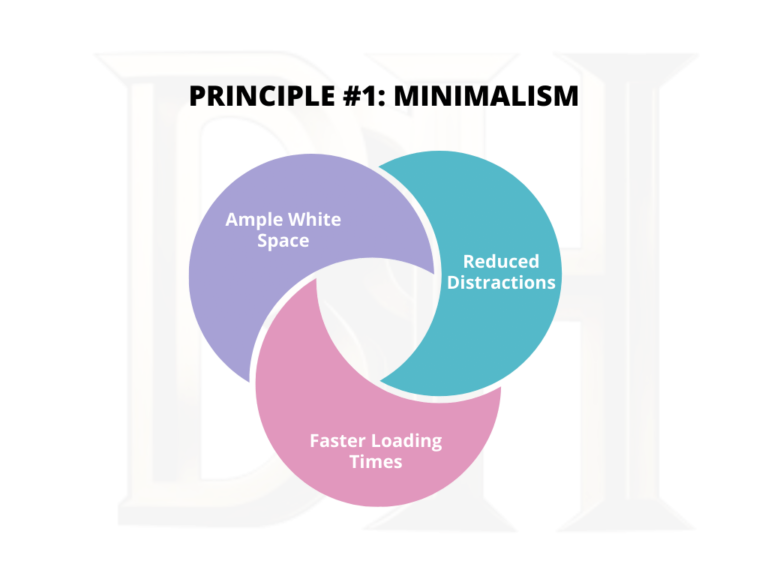
- Ample White Space:
Use white space liberally to give content and elements room to breathe. White space reduces visual noise, making the website look less cluttered and more inviting.
- Reduced Distractions:
Minimalism encourages reducing the number of distractions on a webpage, focusing on what matters most. This helps visitors concentrate on the main message or call to action.
- Faster Loading Times:
A minimalist approach not only enhances user engagement but also ensures a faster loading time. In today’s fast-paced digital world, a quick-loading site is crucial for retaining visitors.
Principle #2: Responsiveness
In an era where people access websites on a multitude of devices, from smartphones and tablets to desktops, responsiveness is paramount. A responsive website adapts to different screen sizes, ensuring a seamless user experience. The key elements of responsiveness include:
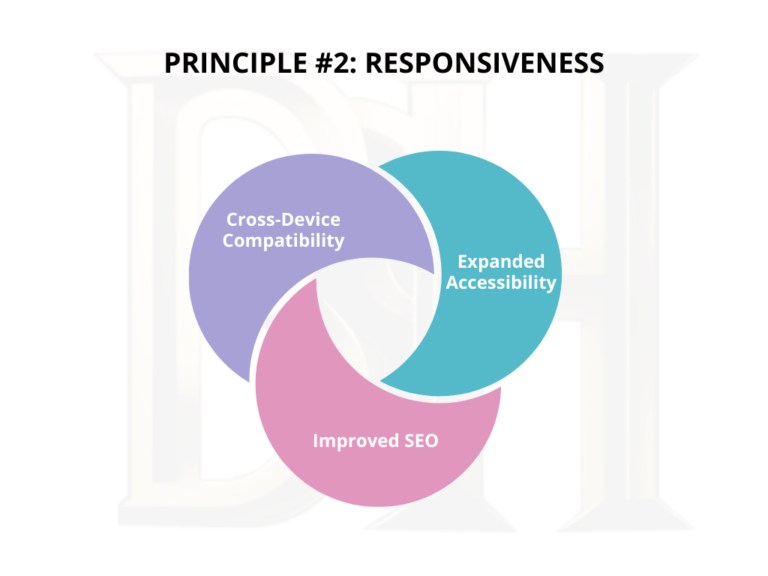
- Cross-Device Compatibility:
Ensure your website performs optimally on all devices. Responsive design enables your site to look and function well on smartphones, tablets, and desktops.
- Improved SEO:
Google prioritizes mobile-friendly websites in its search rankings. A responsive site not only improves user experience but also boosts your site’s SEO, making it more discoverable.
- Expanded Accessibility:
A responsive site caters to a wider audience, improving accessibility and user satisfaction. Your content becomes accessible to users regardless of the device they use.
Principle #3: Accessibility
Accessibility should be at the core of your website design. Making your site accessible to everyone, including people with disabilities, is not just a legal requirement but also a moral imperative. Key considerations for accessibility include:

- Alt Tags for Images:
Use descriptive alt tags for images, providing text descriptions for screen readers. This ensures that visually impaired users can understand the content.
- Keyboard Navigation:
Implement keyboard navigation and other assistive technologies to enable users who can’t use a mouse to navigate your site easily.
- Compliance with Standards:
Comply with accessibility standards such as WCAG (Web Content Accessibility Guidelines) to ensure inclusivity and avoid legal issues. Accessibility isn’t just a “nice-to-have” but a necessity.
Principle #4: Consistency
Consistency in design elements is the foundation of a cohesive and professional-looking website. When your website maintains a uniform appearance, it enhances brand recognition and makes the user experience more predictable. Key aspects of consistency include:
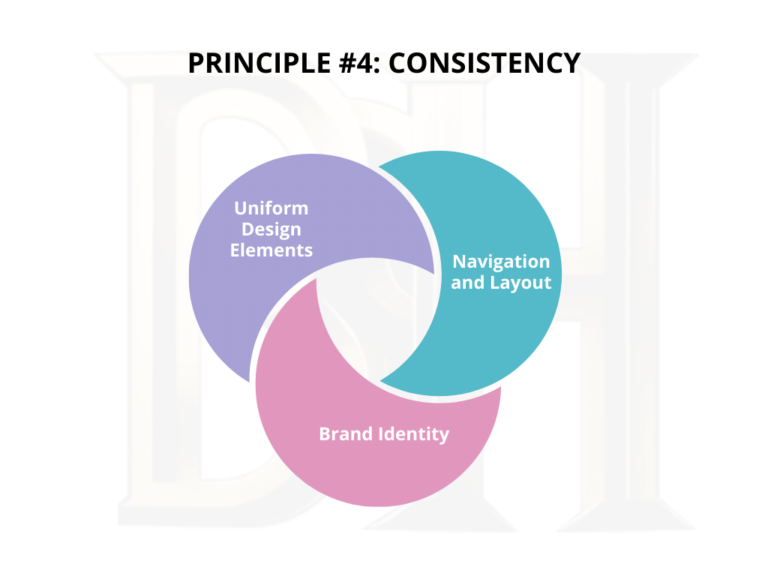
- Uniform Design Elements:
Use consistent design elements, such as color schemes, fonts, and button styles, throughout your site.
- Navigation and Layout:
Maintain uniform navigation and layout structures. This includes keeping the positioning of menus, logos, and other elements consistent across pages.
- Brand Identity:
Consistency in design elements reinforces your brand’s identity and credibility, making your website more memorable to users.
Principle #5: Navigation
Intuitive navigation is the backbone of a user-friendly website. It simplifies the user journey, helping visitors find what they’re looking for with ease. Essential navigation practices include:

- Clear Menus:
Use clear and concise menus, organized in a logical structure. Avoid overwhelming users with too many menu options.
- Breadcrumbs:
Implement breadcrumbs to show users their location within the website. Breadcrumbs make it easy for users to backtrack and explore related content.
- User-Friendly CTAs:
Calls to action (CTAs) play a significant role in guiding users to take desired actions. Ensure your CTAs are prominent and intuitive, making it clear what users should do next.
Principle #6: White Space
White space, or negative space, is the empty area around elements on a webpage. It’s often an overlooked aspect of design but plays a crucial role in enhancing the user experience. The significance of white space in web design includes:

- Improved Readability:
White space reduces visual clutter and helps users focus on the content. It enhances readability, making the text more legible.
- Reduced Visual Noise:
Properly employed white space creates a sense of balance and sophistication. It reduces visual noise, making the website look cleaner and more appealing.
- Balanced Design:
White space provides breathing room for design elements, improving the overall balance of the page. It can highlight important content and elements.
Principle #7: Visual Hierarchy
Creating a clear visual hierarchy is essential for guiding users through your website and drawing their attention to key information. Visual hierarchy is achieved through the strategic arrangement of elements. Key points to consider include:

- Organized Elements:
Organize and prioritize content by arrangin elements to guide the user’s eye. Use size, color, contrast, and positioning to highlight key information.
- Digestible Content:
A clear visual hierarchy makes the content more digestible, allowing users to quickly scan and comprehend the information.
- Engagement:
By effectively using visual hierarchy, you can engage users more effectively and lead them towards specific actions or key messages.
Principle #8: Typography
Typography is a fundamental component of website design, significantly influencing readability and the overall user experience. Key considerations for typography include:
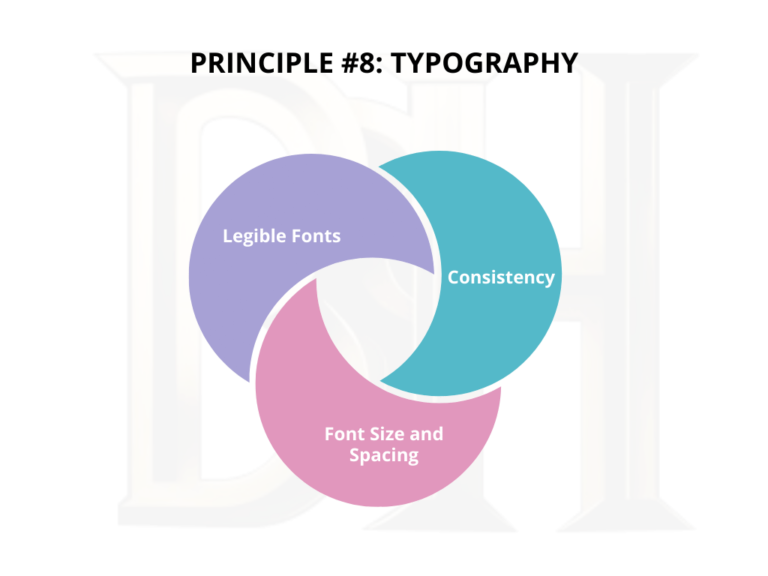
- Legible Fonts:
Choose fonts that are legible on various devices and screen sizes. Avoid overly decorative fonts that may hinder readability.
- Consistency:
Use a limited number of fonts to maintain consistency. Combining too many font styles can lead to a disjointed and unprofessional look.
- Font Size and Spacing:
Consider font size, line spacing, and contrast for optimal readability. Adjust these elements to make your content easy on the eyes
Principle #9: Color Theory
Understanding color theory and its psychological impact is vital in web design. Different colors evoke different emotions and associations. To use colors effectively, consider the following:
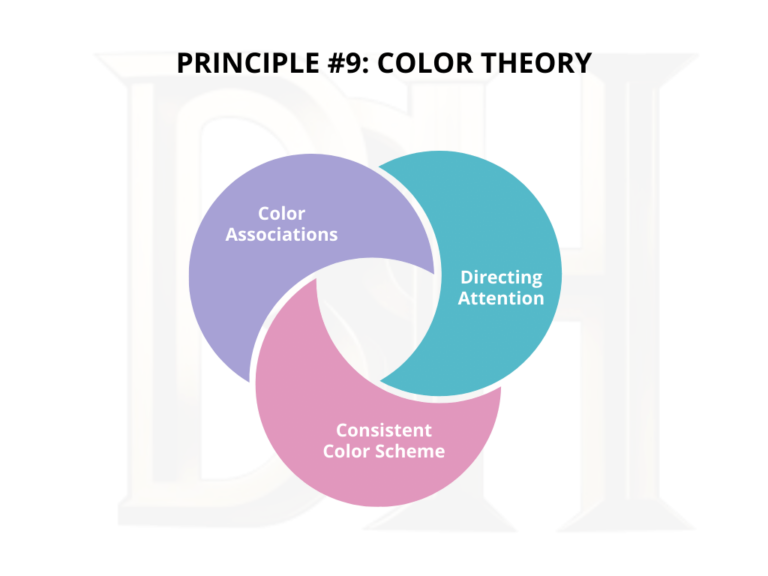
- Color Associations:
Different colors are associated with specific emotions or qualities. For instance, blue conveys trust and professionalism, while red can evoke excitement and urgency.
- Consistent Color Scheme:
Maintain a consistent color scheme throughout your website. This creates a cohesive and visually pleasing look.
- Directing Attention:
Use color strategically to direct attention to important elements, such as calls to action (CTAs). A well-placed color can guide users towards key actions.
Principle #10: User-Centered Design
Finally, always remember that your website should revolve around the needs and wants of your audience. A user-centered design approach is crucial for creating a website that truly resonates with users. Key aspects of user-centered design include:

- User Research:
Conduct user research to understand your target audience better. This involves gathering insights into their preferences, behaviours, and pain points.
- User Personas:
Create user personas to tailor the design to your users’ preferences. Personas represent your ideal users and help you design with their needs in mind.
- Continuous Improvement:
A user-centered design approach doesn’t end with the launch of the website. Continuously gather user feedback and make improvements based on user interactions and evolving user expectations.
In conclusion, effective website design is a fusion of art and science, combining aesthetics with user-focused functionality. By applying these 10 key principles, you can create a website that not only looks appealing but also delivers an exceptional user experience. Whether you’re a seasoned web designer or just starting out, these principles are essential for optimizing your site’s SEO, ensuring user readability, and achieving your web design goals. A well-designed website is not just a digital presence; it’s a powerful tool for engagement, conversion, and success in the online world.
People Also Ask Questions
Examples of minimalist website design include Apple’s website, which uses clean lines, lots of white space, and simple navigation, and Airbnb’s website, known for its uncluttered layout and use of high-quality imagery.
Color psychology can influence user emotions and behavior on a website. For example, blue can convey trust and professionalism, making it a common choice for financial institutions, while red can create a sense of urgency, often used in limited-time offer banners and CTAs.
User personas are essential in web design because they represent your target audience’s characteristics, needs, and preferences. They help ensure that your website design caters to your users, leading to a more user-centered and effective design.
Accessibility in web design is crucial to ensure that websites can be used by people with disabilities. It’s not only a legal requirement but also a way to make the web inclusive, expanding your potential audience and improving your site’s overall usability.
To create a responsive website design, use CSS media queries to adapt your site’s layout to different screen sizes. Ensure images are scalable and use relative units for text size. Test your site on various devices to ensure it looks and functions well across the board.

